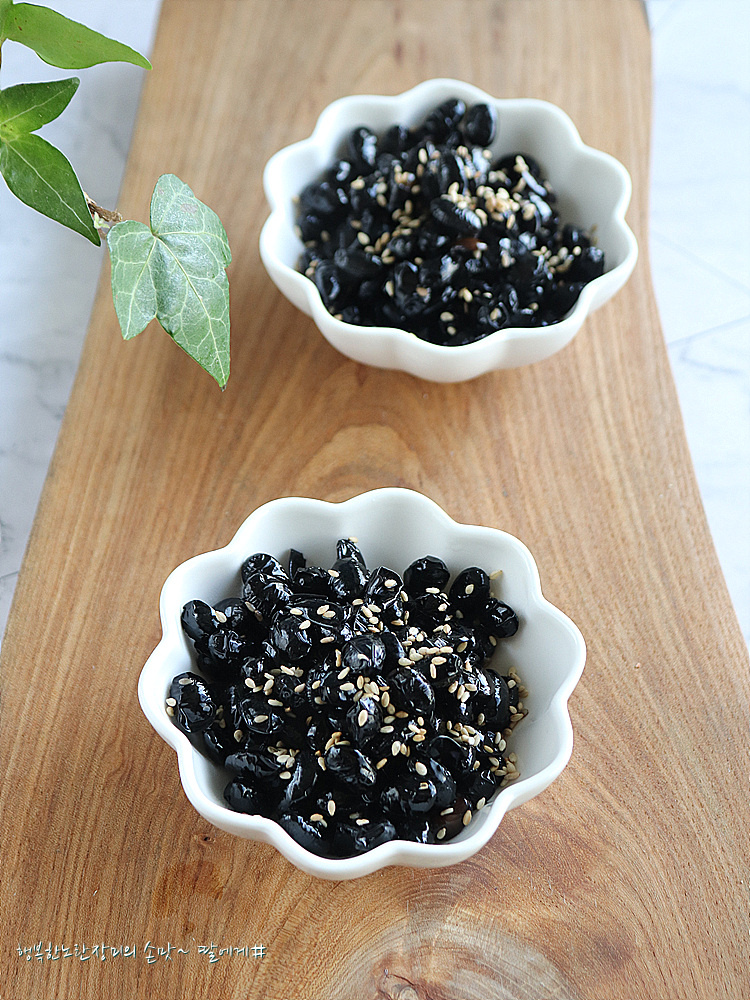Chewy and Sweet Soy-Braised Black Soybeans
How to Make Kongjangjorim: Delicious Seoritae Black Soybean Dish

Kongjangjorim, a beloved side dish from my childhood lunchboxes, is a classic! Even restaurants serve it so well. Lately, I’ve been feeling a bit lazy about cooking, but today I decided to make several side dishes, including this seoritae black soybean banchan. It’s a wonderfully savory and slightly sweet dish that pairs perfectly with rice.
Ingredients- 1 cup Seoritae (black soybeans, approx. 150g)
- 1 to 1.5 cups water (enough to cover the beans)
- 1 piece dried kelp (dasima, approx. 5x5cm)
- 1 Tbsp sugar (adjust to taste)
- 1 Tbsp soy sauce (Korean soup soy sauce or regular)
- 1 tsp oligosaccharide (for gloss and sweetness, optional)
- A sprinkle of toasted sesame seeds
Cooking Instructions
Step 1
First, rinse the seoritae (black soybeans) thoroughly to remove any dust or debris.

Step 2
Add 1 to 1.5 cups of water to the rinsed beans. The amount of water should be enough to fully submerge the beans. Since we’ll be using the soaking water, it’s good to add enough from the start.

Step 3
Let the beans soak for about 1 hour. Once they have plumped up nicely, proceed to the next step. If you prefer a very soft and tender texture, you can soak them overnight in the refrigerator.

Step 4
Kelp (dasima) is an important ingredient that adds umami and a pleasant chewy texture to the dish. Prepare a piece of kelp about 5x5cm and cut it into very small pieces.

Step 5
Prepare the seasoning ingredients. Gather unrefined sugar, soy sauce, and oligosaccharide for gloss and sweetness. (Oligosaccharide is optional.)

Step 6
Now, let’s cook the beans. Pour the soaking water into the pot along with the beans. Start cooking over low heat, and once it begins to boil, increase the heat to medium and cook until the beans are tender.

Step 7
Be aware that beans produce a lot of foam while cooking and can easily boil over. It’s best to use a deep, large pot to make the cooking process much smoother.

Step 8
Add the finely chopped kelp to the pot while the beans are cooking. The kelp will infuse its flavor as it cooks with the beans.

Step 9
It’s crucial to cook the beans thoroughly. You can test for doneness by tasting a bean or piercing it with a chopstick – it should mash easily. (I usually taste them to check!)

Step 10
Once the beans are cooked, add the soy sauce and sugar, stirring until the sugar dissolves. Simmer until the liquid has reduced to a saucy consistency. Be careful not to burn the beans by simmering too high. Finally, add a little oligosaccharide for extra gloss and sweetness. (This is optional.)

Step 11
Finish with a sprinkle of toasted sesame seeds for a visually appealing and flavorful Seoritae Kongjangjorim! This is an excellent side dish, rich in protein. Enjoy it with a bowl of freshly steamed rice!



